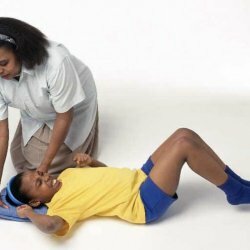Resistant seizures of epilepsy in children
 Resistant epileptic seizures present great difficulties for the physician and especially for the parents. The European Epilepsy Information Service( EPDATA) conducted a serious work to systematize the world experience in the treatment of epilepsy. It turns out that more than 20 percent of cases of childhood epilepsy are resistant to anticonvulsant therapy, both to first and second-line drugs of choice. However, in more than 30% of children, seizures that are considered resistant to therapy may be non-epileptic.
Resistant epileptic seizures present great difficulties for the physician and especially for the parents. The European Epilepsy Information Service( EPDATA) conducted a serious work to systematize the world experience in the treatment of epilepsy. It turns out that more than 20 percent of cases of childhood epilepsy are resistant to anticonvulsant therapy, both to first and second-line drugs of choice. However, in more than 30% of children, seizures that are considered resistant to therapy may be non-epileptic.
Attacks may not respond to treatment if, for example, patients do not receive anticonvulsant therapy for a sufficiently long time, or the doses of the drugs are very small. Carbamazepine, sodium valproate are usually preparations of the first row of choice. In case of their ineffectiveness, the doctor prescribes other drugs: phenytoin, clobazam, clonazepam and others. More modern drugs, such as felbamate, vigabatrin and lamotrigine also have proven to be quite effective.
Causes of attacks
In children, resistant forms of epileptic seizures can be caused by asphyxiation during labor, intrauterine infection, metabolic disorders. However, resistant seizures are often the first sign of such diseases as non-ketogenic hyperglycinemia and Menkes disease. Resistant seizures can take the form of myoclonias, generalized seizures and their combinations. Violations of intelligence in children are more typical for myoclonic forms than for generalized seizures.
Diagnosis
The diagnosis of epilepsy is serious enough in the social and economic sense, therefore it requires a detailed justification. This concerns the fact that more than 30% of children with resistant seizures can not be diagnosed with epilepsy. Anoxic seizures, syncopal conditions, migraine and convulsions of non-epileptic origin can be taken for epilepsy. Moreover, the so-called "resistant forms" can pass as the child grows up.
Studies and observations of 27 children with resistant seizures taking anticonvulsants showed that only 30% of them had decreased and 33% had stopped. These studies also showed that in a group of children with polymorphic attacks, the diagnosis of "epilepsy" is unfounded. Changes in the EEG can sometimes contribute to misdiagnosis. Careful neurologic examination and EEG with video recording of seizures can help to make the correct diagnosis, that is, distinguish epileptic seizures from non-epileptic ones.
Drug Therapy
Anticonvulsants are the basis of treatment. Carbamazepine, like sodium valproate, is usually a basic drug. In case of their inefficiency, clobazam, vigabatrin and lamotrigine are administered. Steroids and immunoglobulins are used in the case of the Landau-Kleffner syndrome. However, their use is not sufficiently effective and not devoid of side effects.
Japanese studies using high doses of valproate( serum levels in excess of 100 μg / ml) for the treatment of children with resistant seizures have shown that such use is particularly effective in cases of Vest syndrome and prolonged peak-wave complexes on the EEG in the slow phase of sleep, And relatively effective in atypical absences and myoclonias. Changes in the blood formula were in some children, but quickly passed after a dose reduction.
Vigabatrin was effective in 50% of cases of partial seizures. Positive action was noted for generalized seizures. However, vigabatrin was ineffective in absences and myoclonias. In 10% of children, he caused hyperactivity, somnolence and ataxia.
Infantile spasms or Vest syndrome usually begin before the year. They are difficult to diagnose and have a poor prognosis. In this case, primarily prescribed corticosteroids, however, recent studies have shown that it is possible to successfully use vigabatrin. The encouraging results of the use of vigabatrin in infantile spasms allow us to recommend it as monotherapy. The authors of the technique believe that if vigabatrin does not give an effect within 4-5 days, then another therapy should be applied.
In some studies, vigabatrin was used in combination with other drugs in 68 children with resistant forms. In 29 children, seizures stopped, in 46 children decreased by 50%.In 3/4 children with syndromic infantile spasms and more than one-third with cryptogenic infantile spasms, a long-term remission was noted. Side effects were not observed in 52 children.
Lennox-Gastaut syndrome and seizures as a result of encephalopathy account for approximately 5% of children with epilepsy. The most effective in these cases are felbamate and lamotrigine. A new preparation of felbamate in the study showed efficacy in partial seizures and Lennox-Gastaut syndrome. The drug lamotrigine was particularly effective against atonic attacks.
Other treatments for
When medication is ineffective, surgical treatment may be suggested. For example, removal of the temporal lobe and partial dissection of the corpus callosum. These interventions are particularly effective with regard to partial and atonic-astatic seizures. As the surgical technique improves, the results are increasingly encouraging. Before the surgery, it is necessary to compare the degree of risk and the effect of drug therapy.
You can apply and psychotherapy, especially if there are behavioral changes. For some children hypoallergenic and ketogenic diet is useful. Every year the methods of treatment are improved. Perhaps in the future, epilepsy will cease to be such a formidable disease.



